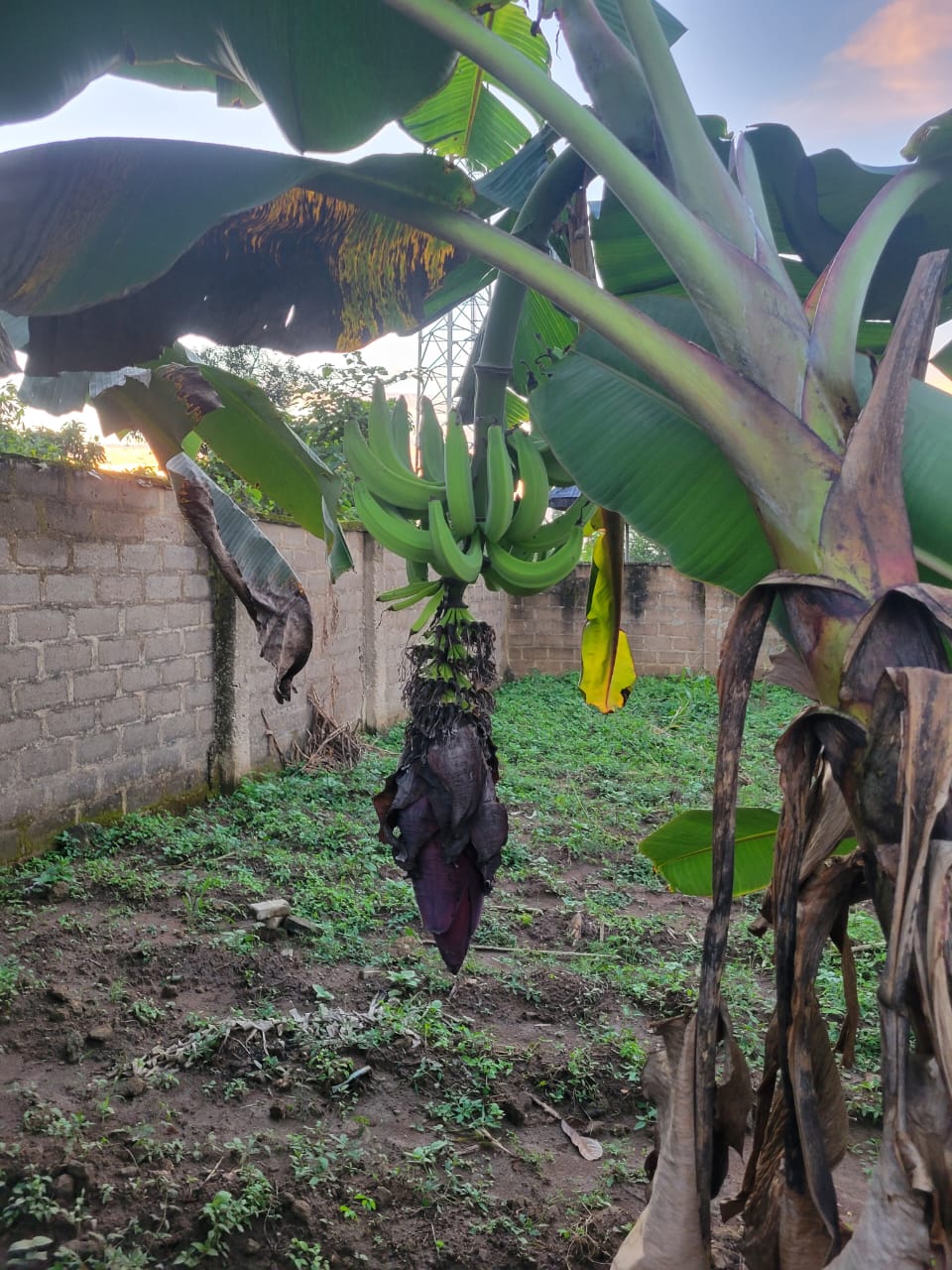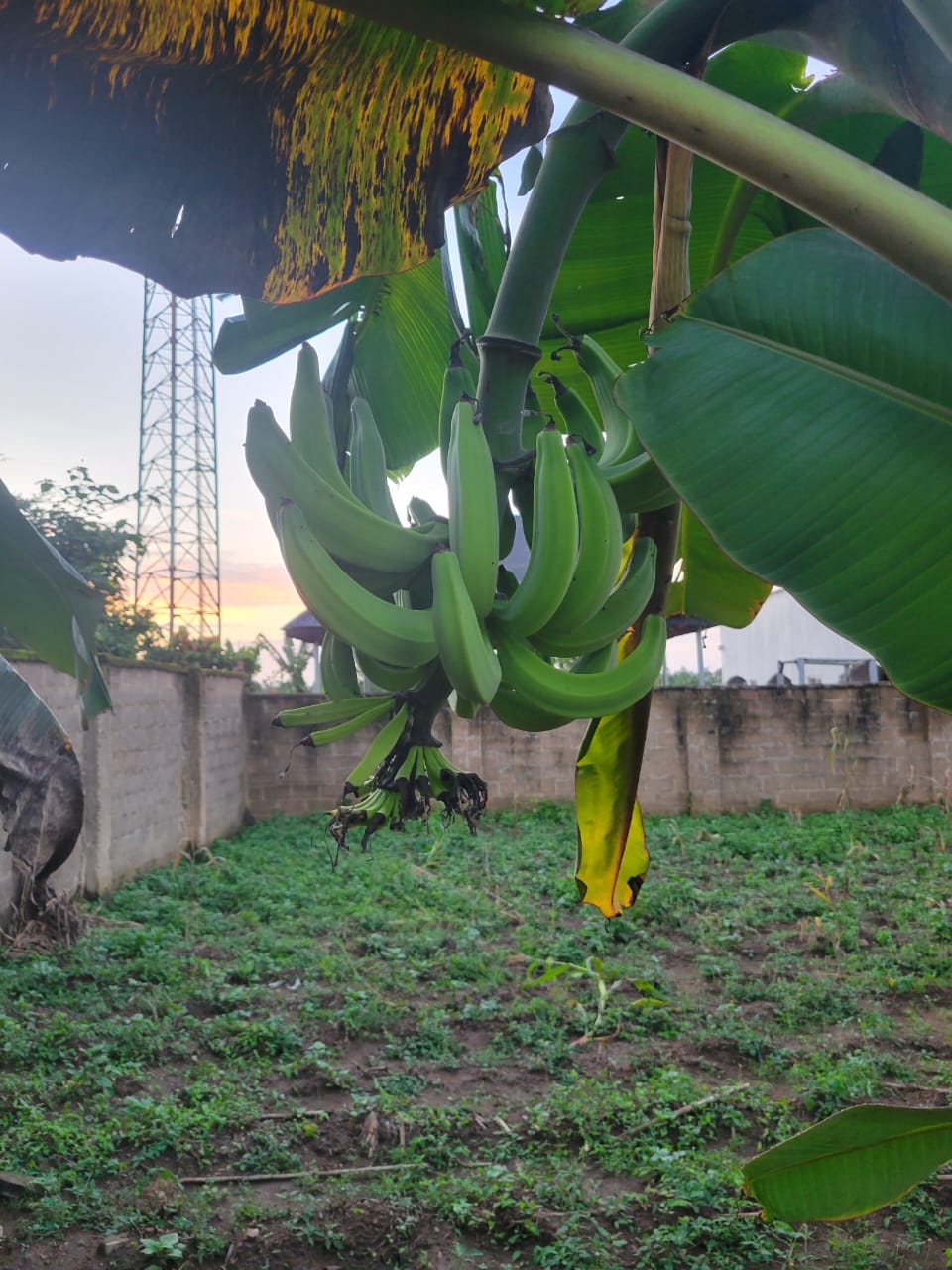When I walk into my plantain farm in the cool of the evening, there’s always this feeling of quiet satisfaction. The tall, broad leaves sway gently, the stems stand like green pillars, and in between, the heavy clusters of fruit hang proudly, bending toward the soil as if weighed down by promise. But farming, I’ve learned, is not just about admiring nature; it’s about making decisions that could mean the difference between an abundant harvest and a disappointing one.
Recently, I made one such decision. On some of my fruiting plantain trees, I noticed the long male buds drooping under the bunch. That purple, cone-shaped structure at the tip was still there, along with flower loads that had no chance of becoming fruits. I stood there, machete in hand, and thought: Should I let it remain, or should I cut it off?
I chose to cut it.
 Before cutting the flower bud
Before cutting the flower bud
Why I Did It
My reasoning was simple. Those leftover flowers were never going to turn into plantains. They were dead weight, and in my mind, they were still drawing energy from the plant. Energy that could be better directed to the fruits already hanging. By cutting them away, I hoped to channel all the resources, such as nutrients, water, and sugars, straight to the bunch.
Think of it like managing a household budget. If you’ve got too many mouths to feed, everyone gets a smaller portion. But if you stop spending on unnecessary items, suddenly the essentials are well covered. That’s the same logic I applied to my plantain. My skill as a Botanist doesn't even need to be at play.
 After cutting the flower bud
After cutting the flower bud
What the Science Says
Of course, being curious, I dug into the science of it. Plantains, like bananas, grow from an inflorescence. Female flowers at the top become fruits, while male flowers at the bottom end up as sterile buds. Once pollination is over, those male flowers are basically redundant.
Some studies say cutting off the male bud can help because fruits are strong sinks. They attract and demand more nutrients. Removing the competition might allow the bunch to grow fuller and heavier. Plus, that dangling bud often becomes a hiding place for pests and fungi. By cutting it off, I also reduce the chance of diseases like black sigatoka spreading. Even to a layman, the dangling bud constitutes an excess weight that can pull down the entire plant.
The Other Side of the Story
But not everyone agrees. Some agricultural researchers argue that the male bud doesn’t really drain much energy compared to the growing fruits. In fact, the resource savings from cutting it are sometimes so small that they don’t even affect the final yield. Interestingly, those dangling flowers can act like decoys, attracting pests away from the actual fruits. Cutting too early could expose the plantain bunch to more attacks from insects like thrips.
That got me thinking. Maybe it’s not a one-size-fits-all rule. In rich, fertile soils where nutrients and water are plentiful, the plantain doesn’t struggle to feed both fruits and flowers. But in tougher conditions, such as poor soil, little rain, and high pest pressure, removing the excess might actually make a visible difference.
My Farmer’s Perspective
At the end of the day, farming is as much about instinct as it is about data. I look at my plantain tree, and I ask myself: What will give these fruits the best chance? For me, cutting the redundant flowers is like pruning a tree or weeding a farm. It’s about removing what’s unnecessary so that what truly matters can thrive.
Even if the scientific gains are small, I see other benefits. The bunch looks cleaner, airflow improves, pests have fewer hiding places, and I feel reassured that I’ve done my part to help my plantains grow strong. And trust me, in farming, that peace of mind is worth more than most people realize.
The Bigger Lesson
This little practice of cutting away plantain flowers is a reflection of a bigger truth in life and farming: growth often requires pruning. Whether it’s in plants, business, or personal life, sometimes we have to cut off what doesn’t serve us, so we can focus energy where it truly counts.
So, will this make my plantains twice as big? Maybe not. But it will give them a better shot at reaching their potential. And when harvest time comes, and I see those firm, filled-out fruits, I’ll know that the small act of trimming away the extras was worth it.
Farming is about choices. Some are backed by tradition, others by science, and many by gut feeling. This choice was mine. And in my farm, it felt like the right one.
Resources
- Mustaffa, M & Kumar, V. (2012). Banana Production and Productivity Enhancement through Spatial, Water and Nutrient Management. Journal of Horticultural Sciences. 7. 1-28. 10.24154/jhs.v7i1.383.
- EFFECT OF MALE BUD REMOVAL ON THE YIELD OF MUSA GENOTYPES IN A HUMID FOREST ZONE OF WEST AFRICA
- Banana and Plantain (Musa acuminata & balbisiana hybrids)
Posted Using INLEO